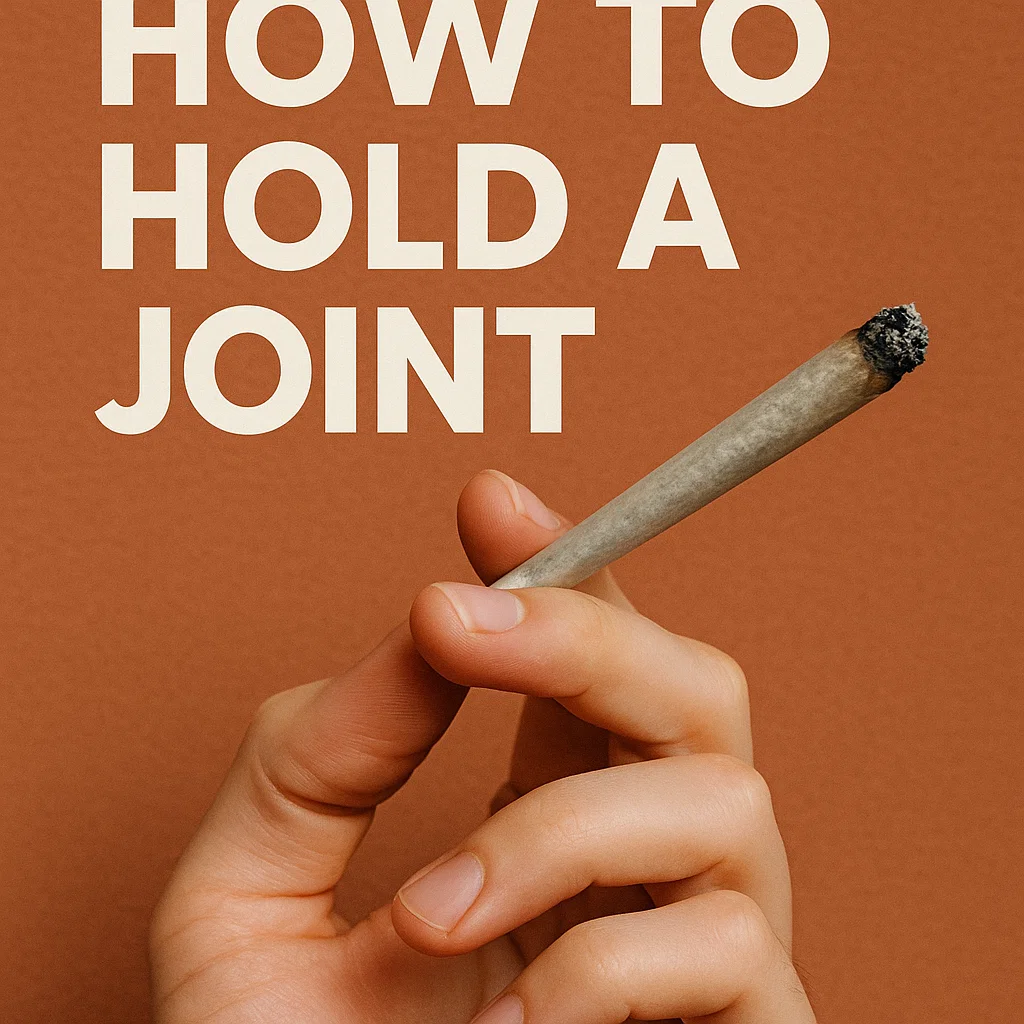How to Hold a Joint

How to Hold a Joint: Grip, Comfort, and Etiquette for Real-World Sessions
Holding a joint looks simple until you are on a windy patio, your fingers are cold, and the paper starts to canoe. The way you grip and handle a joint changes how evenly it burns, how smooth it feels, and how comfortable everyone is when you pass it around. This guide keeps things practical. You will learn stable grips that work in different settings, how to protect the cherry, how to pass without crushing the tip, and a few easy fixes when things go sideways.
If you need a few practice rolls or pre-ground options, browse the current menu in the shop. For general questions on shipping and products, the quick answers live in our FAQ.
Start with the mouthpiece
A good hold begins before you touch a lighter. The mouth end needs to be firm enough that you can handle the joint without collapsing the paper.
Use a filter, tip, or crutch.
A small paper tip or pre-formed cardboard crutch keeps the end open and gives your fingers something solid to pinch. It also stops loose flecks from reaching your lips. If you prefer glass, a reusable glass tip adds more structure and stays cool between pulls.
Pack the end gently.
Tap the filter end on the table once or twice to settle the grind. Do not hammer it flat. Over-packing starves airflow and forces you to grip harder, which damages the paper.
Check for soft spots.
Before you light, roll the joint between your thumb and index finger. Any soft dips near the filter are weak points that collapse when you hold tightly. A tiny twist of the paper can firm them up.

The relaxed pinch for smooth, even pulls.
Core grips that work almost anywhere
Everyone’s hands are different, so think of these as templates. Try each one and keep two you like. Switch depending on weather, group size, and what you are doing with your other hand.
The relaxed pinch
Hold the filter between the pads of your thumb and index finger, like you would a pen you are about to hand to a friend. Let the joint rest at a slight downward angle so ash falls away from you. This is the classic solo grip because it is light, stable, and easy to pass forward.
When to use it: indoors, calm weather, one-handed situations like walking a short distance or opening a door.
The three-point support
Pinch the filter with thumb and index, then let the middle finger touch the underside as a brace. The extra contact spreads pressure so you do not crush the tip. It steadies a long joint and helps when the paper is thin.
When to use it: group sessions, longer rolls, or if your hands are a little shaky after coffee.
The wind block
Make a loose “C” with your hand. Pinch the filter with thumb and index, then arc your other fingers ahead of the cherry like a shield. Your hand becomes a small windbreak while you draw. This keeps the burn even outdoors.
When to use it: patios, parks, concerts, any place with a breeze.
The overhand cradle
Turn your palm down. Pinch the filter between the side of your index finger and the flat of your thumb so the joint points forward like a short pencil. Rest the barrel along the first knuckle of your middle finger. This hides the cherry from view and keeps smoke away from someone standing face-to-face.
When to use it: crowded sidewalks or any time you want to be discreet and keep ash under control.
The two-handed cup
Hold the filter with your off hand using a relaxed pinch. Set your dominant hand a few centimeters forward to cup the cherry and guide the draw. You are not squeezing the paper with the front hand, only shaping the air around the tip while you inhale. It feels a bit like holding a small candle and guarding the flame.
When to use it: cold nights, light rain, or when a joint starts to canoe and needs gentler airflow.
How hard should you pinch?
Less than you think. Good airflow lets you hold lightly. If you find yourself squeezing hard to get a pull, something upstream needs attention: the grind is too fine, the joint is packed too tight, or the filter is collapsing. Light pressure keeps the paper round and prevents hot spots.
An easy habit is to pinch with just enough force to keep the joint off the floor if someone bumps your arm. Anything more is usually wasted effort.
Lighting and the first hold
A clean light sets up an easier hold for the next ten minutes. Toast the end slowly while rotating the joint. Keep the flame a little away from the paper instead of ramming it into the tip. Once the cherry glows evenly, move to your relaxed pinch and take a short primer pull. If the smoke feels sharp right away, your light was too aggressive. Let the cherry cool for a second, then continue.
If you are testing a new strain and want flavor first, start with a small, tidy joint. Something bright like Sour Diesel Small AAA shows its lemon-diesel notes when you keep the cherry small and the hold gentle.
Passing etiquette without crushing the tip
A joint that travels around the room should look the same when it returns. Treat the filter like the handle of a teacup. Pinch the handle, not the hot glass.
-
Offer the filter end toward the next person, not the burning tip.
-
Keep your fingers below the lip that touches the mouth.
-
If the filter is short, pass using the three-point support so you do not collapse it at the handoff.
-
Wipe your fingers if you have food or hand cream on them. Oil weakens paper.
When you receive a joint, do not pinch at the very edge of the filter. Hold slightly back from the lip so you are not squeezing the exact spot someone else just used. Small courtesies keep sessions comfortable.
How to hold a joint so it burns straight
Uneven burns start with uneven airflow. Your hold can save or sink a canoe.
Keep the joint level or slightly down.
If you point it up like a flute, heat climbs toward the high side and the paper burns faster there.
Control wind with your off hand.
Even a small draft can turn a nice roll lopsided. The wind block or two-handed cup evens the pull.
Rotate between pulls.
A quarter turn each time avoids hot spots. Think of turning a skewer over a fire.
Feather the draw.
A long hard pull superheats one side of the cherry. Two shorter sips keep temperature stable.
If a canoe starts anyway, wet your fingertip with a little water and dab the fast-burning edge. Give a tiny helper light to the slow side while using the wind block. Most small canoes correct within a minute when you reduce airflow and guide the cherry.
Comfort grips for long fingers, small hands, and sore joints
Hands vary. There is no single correct hold. If a standard pinch feels awkward, try these adjustments.
Small hands
Shorten the joint with a firmer filter or a glass tip. The three-point support gives you control without needing a wide span.
Long fingers
Use the overhand cradle to keep the joint away from your nails and keep ash under your line of sight.
Arthritis or sore thumb joints
Consider a clip. A simple roach clip or a reusable holder takes pressure off your fingers. Hold the handle like a pen so the joint rests on the clip rather than your joints bearing the pinch.
Gloves or winter holds
With gloves on, use the two-handed cup and pinch the filter between glove fingers only long enough to pass. In very cold weather, a glass tip makes the grip easier because the mouthpiece stays rigid and round.
Managing ash with one hand
Ash control is part of the hold. An even, compact ash insulates the cherry. Too much ash chokes the draw. The sweet spot is to tap gently every few pulls.
-
Keep the joint angled slightly down.
-
Tap the side of your index finger with your middle finger to send a gentle nudge along the paper.
-
Ash into a tray or the ground, not the wind.
-
If a stubborn cone of ash clings, it is usually a sign the cherry went cool. Take a small pull, let the tip glow, then tap again.
Avoid flicking the tip like a cigarette. That move can crack the cherry and cause a canoe.
Holding pre-rolls vs hand-rolled joints
Pre-rolls often have tighter crutches and denser packing. Start with the three-point support so you do not crush the filter while you learn the airflow. For your own rolls, adjust the filter firmness to your hands. If you tend to hold tightly, add one extra layer to the paper crutch so it resists pinching.
If you want a no-stress practice joint while you refine your hold, grab something forgiving with a smooth finish like Premium Pink Kush Indica. The creamy draw stays comfortable even if your grip is a little firm at first.
How to hold a joint while talking, walking, or multitasking
Talking
Move the joint slightly away from your face when you speak. The overhand cradle helps because the cherry points forward while your palm blocks embers from drifting toward someone listening.
Walking
Use the relaxed pinch and keep your arm slightly away from your body. Watch wind direction. A two-handed cup when you inhale prevents the cherry from flaring as you move.
Opening doors or handling objects
Switch to your non-dominant hand for the joint and keep your dominant hand free. Practice flipping between the relaxed pinch and the three-point support. The change takes half a second and keeps you from dropping the roll when you need a stronger grip.
Using your phone
Hold the joint in your non-dominant hand and rest your pinky under the filter like a tiny shelf. This keeps ash off the screen and gives the joint a safe perch between pulls.
Holding a roach without burning fingertips
As the joint shortens, your grip needs more structure. Three options keep fingertips safe:
-
Use a real filter. A longer tip means the hold feels the same from start to finish.
-
Roach clip or holder. Pinch the handle, not the paper, and keep the cherry a few centimeters away from your skin.
-
Paper jacket. Wrap a narrow strip of thick paper around the last centimeter and twist once. The jacket becomes a temporary handle for the final pulls.
If you are passing to others, switches like clips and paper jackets also keep things hygienic near the end.

Three-point support for steadier passes.
Group holds and courtesy
A good hold includes awareness of who you are with.
-
Keep the cherry pointed away from faces when you gesture.
-
Pass in a consistent direction so no one feels rushed.
-
If someone coughs, give a second before you hand them the joint.
-
If a person sets the joint down on a tray, do not grab it from the air. Lift it from the tray with a relaxed pinch so the filter stays intact.
Small, calm movements make a session feel relaxed and respectful.
Fixing common hold problems
Crushed filter
If the crutch collapses, the draw tightens and you start squeezing harder, which makes it worse. Roll the filter gently between fingers to round it out, then switch to the three-point support. For the next joint, build a firmer crutch.
Slippery paper
Lotion or sweat on fingers can make the paper slide. Wipe your fingertips, then pinch a little farther back from the lip where the filter is wider.
Hot cherry too close
If you feel heat on your fingers, extend the joint with a clip or paper jacket. Do not try to grip closer to the burn to control it. A longer handle gives you room to relax your hand.
Outdoor gusts
Use your off hand to cup the tip, take shorter sips, and rotate the joint between pulls. If wind is strong, face slightly sideways to create your own windbreak.
Holding during a cleanup draw
Sometimes a joint nears the end and the cherry looks ragged. Before you retire it, try a cleanup draw:
-
Hold with the two-handed cup.
-
Take one short pull while slowly turning the joint.
-
Tap ash gently.
-
Take a final, small draw to confirm the burn is even.
-
If it flares or tastes harsh, it is time to set it down.
Knowing when to stop is part of good handling. A comfortable finish is better than chasing a last hot puff.
Practice plan that actually helps
The fastest way to learn is to roll or buy two small joints and practice both hands. Use easy-going flower and a medium filter length. Smoke half a joint with your dominant hand, focusing on a light pinch and smooth rotation. Switch hands for the second half. Next session, reverse the order. Within a few nights your off hand will feel almost as natural as your main one.
If you prefer to focus on flavor while you practice, keep a few strains on hand and rotate so you do not overload your senses. Our blog posts often feature gentle hybrids and smooth indicas that make learning comfortable. When questions pop up, message us on the contact page and we will point you to a simple setup.
Final take
Holding a joint is a small skill that pays off every time you light up. Build it around three habits. First, give yourself a firm mouthpiece with a decent filter so your grip can stay light. Second, choose a hold that fits the moment, whether that is the relaxed pinch for calm rooms, the wind block for patios, or the three-point support for steady passes. Third, guide the cherry by managing airflow with your off hand and rotating between pulls. Do those things and the burn stays even, the paper stays intact, and the whole session feels smoother.
When you are ready to practice with a few friendly jars, the live menu in the shop has fresh options every week. Pick one daytime lift and one evening comfort, invite a couple of friends, and put these holds to work.

